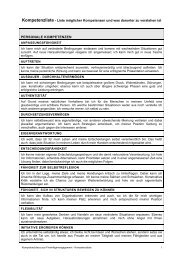Sexuell grenzverletzende Kinder â Praxisansätze und ihre ...
Sexuell grenzverletzende Kinder â Praxisansätze und ihre ...
Sexuell grenzverletzende Kinder â Praxisansätze und ihre ...
Erfolgreiche ePaper selbst erstellen
Machen Sie aus Ihren PDF Publikationen ein blätterbares Flipbook mit unserer einzigartigen Google optimierten e-Paper Software.
Nowara, S. & Pirschke, R. (2005). Abschlussbericht des Forschungsberichts “Erzieherische Hilfen<br />
für jugendliche Sexual(straf)täter” im Auftrag des Ministeriums für Ges<strong>und</strong>heit, Soziales,<br />
Frauen <strong>und</strong> Familie des Landes Nordrhein-Westfalen. Verfügbar unter:<br />
https://services.nordrheinwestfalendirekt.de/broschuerenservice/download/1161/Erzieherische-<br />
Hilfen.pdf (Zugriff: 27.01.2012).<br />
Okami, P. (1992). „Child perpetrators of sexual abuse“: The emergence of a problematic deviant<br />
category. The Journal of Sex Research, 29 (1), 109-130.<br />
Pithers, W.D., Gray, A., Busconi, A. & Houchens, P. (1998a). Five empirically subtypes of children<br />
with sexual behavior problems. Child Maltreatment, 3, 384-406.<br />
Pithers, W.D., Gray, A., Busconi, A. & Houchens, P. (1998b). Caregivers of Children with Sexual<br />
Behavior Problems: Psychological and Familial Functioning. Child Abuse & Neglect, 22, 129-<br />
141.<br />
Pithers, W., Gray, A.S., Cunningham, C. & Lane, S. (1993). From trauma to <strong>und</strong>erstanding. Brandon:<br />
Safer Society Program & Press.<br />
Priebe, B. (2008). Rückfallprophylaxe bei jungen Sexualstraftätern: Erfahrungen aus der<br />
ambulanten Arbeit mit sexuell <strong>grenzverletzende</strong>n <strong>Kinder</strong>n <strong>und</strong> Jugendlichen. Zeitschrift für<br />
Sexualforschung, 21, 249–268.<br />
Quayle, E. & Taylor, M. (2006). Young people who sexually abuse. The role of the new technologies.<br />
In M. Erooga & H. Masson (Hrsg.), Children and young people who sexually abuse others.<br />
Current developments and practice responses (S.115-127). London: Routledge.<br />
Rasmussen, L. A., Burton, J.E. & Christopherson, B.J. (1992). Precursors to offending and the<br />
trauma outcome process in sexually reactive children. Journal of Child Sexual Abuse, 1 (1),<br />
33-48.<br />
Ray, J.A. & English, D.J. (1995). Comparison of female and male children with sexual behavior<br />
problems. Journal of Youth and Adolescence, 24 (4), 439-451.<br />
Reynolds, M.A., Herbenick, D.L. & Bancroft, J. (2003). The nature of childhood sexual experiences.<br />
In: J. Bancroft (Ed.). Sexual development in childhood (S. 134-155). Bloomington: Indiana<br />
University Press.<br />
Romer, G. (2002). <strong>Kinder</strong> als „Täter“. In Bange, D. & Körner, W. (Hrsg.). Handwörterbuch<br />
<strong>Sexuell</strong>er Missbrauch (S. 270-277). Göttingen: Hogrefe.<br />
Ryan, G. (2000). Childhood sexuality: A decade of study. Part 1 – Research and curriculum development.<br />
Child Abuse & Neglect, 24 (1), 33-48.<br />
Ryan, G. & Lane, S. (Hrsg.) (1997). Juvenile sex offending: Causes, consequences and corrections<br />
(2.Aufl.). San Francisco: Jossey-Bass.<br />
Ryan, G. & Blum, J. (1994). Childhood sexuality: A guide for parents. Denver: Kempe Children’s<br />
Center, University of Colorado Health Sciences Center.<br />
Ryan, G., Blum, J., Sandau-Christopher, D., Law, S., Weher, F., S<strong>und</strong>ine, C., Astler, L., Teske, J.<br />
& Dale, J. (1993). Understanding and responding to the sexual behavior of children: Trainer’s<br />
manual. Denver: Kempe Children’s Center, University of Colorado Health Sciences Center.<br />
Sandnabba, N.K., Santtila, P., Wannäs, M. & Krook, K. (2003). Age and gender specific sexual<br />
behaviors in children. Child Abuse and Neglect, 27, 579 – 605.<br />
Santtila, P., Sandnabba, N.K., Wannäs, M. & Krook, J. (2005). Multivariate structure of sexual behaviours<br />
in children: Associations with age, social competence, life stressors and behavioural<br />
disorders. Early Child Development and Care, 175, 3-21.<br />
Schlingmann, T. (2011). Die gesellschaftliche Bedeutung sexueller Gewalt <strong>und</strong> <strong>ihre</strong> Auswirkung<br />
auf männliche Opfer. In: Beratungsstelle kibs (Hrsg.), “Es kann sein, was nicht sein darf”.<br />
Jungen als Opfer sexualisierter Gewalt. Dokumentation der Fachtagung am 19./20.11.2009 in<br />
München (S. 122-134). <strong>Kinder</strong>schutz e.V.<br />
Schoentjes, E., Deboutte, D. & Friedrich, W. (1999). Child sexual behavior inventory: A Dutchspeaking<br />
normative sample. Pediatrics, 104, 885-893.<br />
Schoenwald, S.K., Letourneau, E.J. & Halliday-Boykin, C.A. (2005). Predicting therapist adherence<br />
to a transported family-based treatment for youth. Journal of Clinical Child and Adolescent<br />
Psychology, 34, 658-670.<br />
Schuhrke, B. & Arnold, J. (2009). <strong>Kinder</strong> <strong>und</strong> Jugendliche mit problematischem sexuellen Verhalten<br />
in (teil-)stationären Hilfen zur Erziehung. Praxis der <strong>Kinder</strong>psychologie & <strong>Kinder</strong>psychiatrie,<br />
58, 186-214.<br />
Schuhrke, B. (2002a). <strong>Sexuell</strong> auffälliges Verhalten von <strong>Kinder</strong>n. In. D. Bange & W. Körner (Hrsg).<br />
Handwörterbuch <strong>Sexuell</strong>er Missbrauch (S. 542-547). Göttingen: Hogrefe<br />
Schuhrke, B. (2002b). <strong>Sexuell</strong>e Entwicklung von <strong>Kinder</strong>n bis zur Pubertät. In. D. Bange & W.<br />
Körner (Hrsg). Handwörterbuch <strong>Sexuell</strong>er Missbrauch (S. 548-553). Göttingen: Hogrefe<br />
Shaw, J.A., Lewis, J.E., Loeb, A., Rosado, J. & Rodriguez, R. (2000). Child on child sexual abuse:<br />
Psychological perspectives. Child Abuse & Neglect, 24 (12), 1591-1600.<br />
Silovsky, J.F. & Letourneau, E.J. (2008). Introduction to special issue on children with sexual behavior<br />
problems. Child maltreatment, 13 (2). 107-109.<br />
112

















